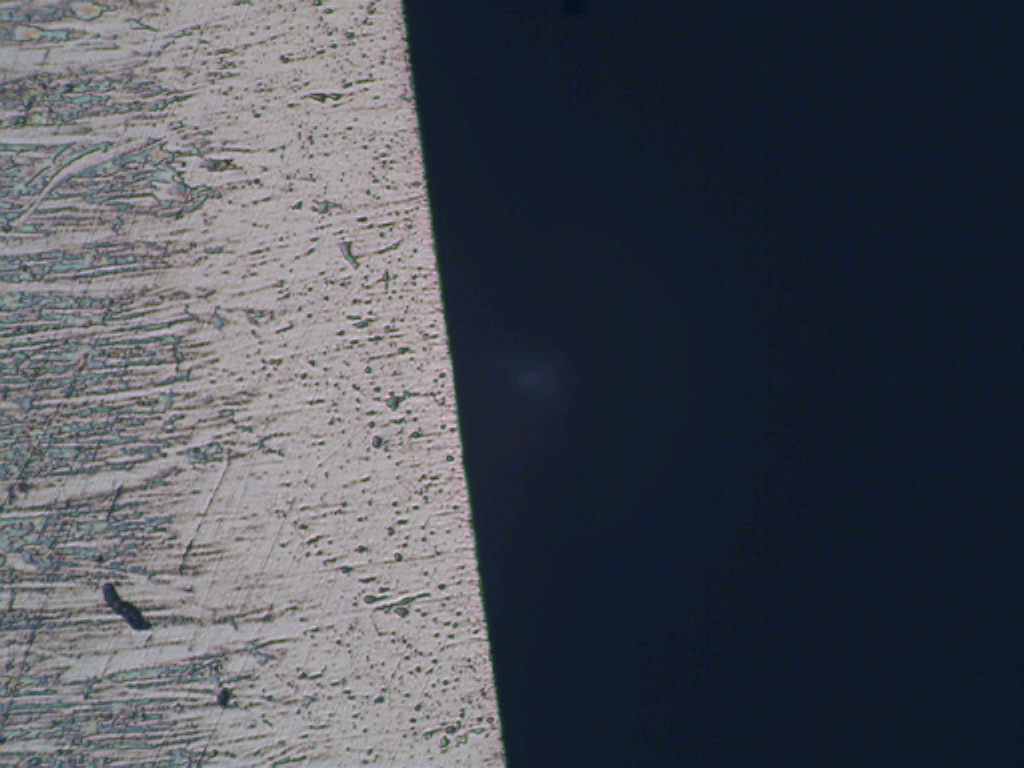You can also pick up a big bar of green buffing compound on amazon for about a fiver, if you prefer a more solid format.Bm101":1ciareek said:Sam autosol is a handy thing to have, a tube is under a fiver. A scrap of mdf is always skipdippable. Your stropping worries are sorted for years for the price of a quiet sunday pint and a packet of sharpening thread popcorn.
O
You are using an out of date browser. It may not display this or other websites correctly.
You should upgrade or use an alternative browser.
You should upgrade or use an alternative browser.
Easiest Blade and Chisel Sharpening
- Thread starter bp122
- Start date

Help Support UKworkshop.co.uk:
This site may earn a commission from merchant affiliate
links, including eBay, Amazon, and others.
Depends how much you use them, years at least though, even for a frequent user. Paul Sellers reckons to get ten years out of his and they're being used for his woodworking school, so I would imagine a few decades for most of us.Jacob":1kf3284i said:I've got some Ezelap diamond plates which work fine but I still prefer the oil stone somehow. A lot cheaper too and probably longer lasting. How long do diamond plates last I wonder?
Thanks!! I have all of that stuff so will give it a go!ED65":1925enve said:Want one by the end of the day? Build dis. Maybe a 10-minute job if you have two suitable scraps of wood and a couple of screws or bolts. There's no requirement to use T-nuts or threaded inserts, this will give greater durability but the screws can tap straight into the wood and the jig will still last a long time.sammy.se":1925enve said:Still need a honing guide...
Most metal polishes, including Brasso or a white stainless steel polish, hob creams and a few car compounds like T-Cut will work as stropping compound if you have any of those. If there's an artist in the family Chromium Oxide oil paint can also be used.sammy.se":1925enve said:...and some strop paste.
If you have nothing at all suitable Autosol and Peek are good tube polishes to pick from. They work about the same so just pick whichever you can get cheapest.
Sent from my SM-G973F using Tapatalk
Rich C":3d0ahy9v said:Depends how much you use them, years at least though, even for a frequent user. Paul Sellers reckons to get ten years out of his and they're being used for his woodworking school, so I would imagine a few decades for most of us.Jacob":3d0ahy9v said:I've got some Ezelap diamond plates which work fine but I still prefer the oil stone somehow. A lot cheaper too and probably longer lasting. How long do diamond plates last I wonder?
You'll find the ezelaps to last next to forever if you don't care that they slow down.
Oilstones are multi-generational, except for crystolon or similar friable grinding stones. They are better for bevel grinding than any diamond stone, though.
The solution to the ezelaps wearing to slowness is just to have them a step up in speed/coarsness and expect them to slow down. For example, the 600 is probably not as fast as most 1000 waterstones once it's broken in, but it's not far off. The 1200 becomes slow, but slow becomes finer. The method I described works well with diamond stones, and is less dependent on their speed because the grinder does most of the work. I guess because of that, it's really not dependent on stone type at all because there isn't any commonly used media that won't work well with it.
orchard
Established Member
nabs":1x985yyb said:bp122 it honestly isn't as complicated as the internet makes it appear
My advice, as a fellow beginner, is that If you don't have access to someone who can show you how to do it then this video series on sharpening is comprehensive, straight forward and easy to follow:
https://www.theenglishwoodworker.com/sh ... and-tools/
£26 well spent if it means you can escape the maddening world of internet sharpening debates (you can easily spend several times that amount on sharpening paraphernalia that you will never use - I did!)
Having said that, if you'd rather save the money, his advice is essentially the same as D_W and jacob above: for most jobs he just uses a couple of oil stones (one rough and one smooth, or a single stone with two sides) and sharpens free hand. It doesn't take long to get the hang of it.
+1 - as a noob, these systems yield results.
One important thing to take from his series is one's system should be determined by the type of steel you want to sharpen.
Jacob
New Luddism. Awake and resist!
Can't say I've ever noticed a prob with any steel on an oil stone. They are different which basically means they take different amounts of time. It's just too easy to be distracted by pseudo-technical sharpening enthusiast issues, simpler head down brain off, just do it, keep it simple.orchard":jto1qzmr said:...
One important thing to take from his series is one's system should be determined by the type of steel you want to sharpen.
The only issues I've ever found (and only one of them has to do with tools instead of knives) is that A2 steel will give up chunks to a washita stone. Not to a translucent or black arkansas stones, just a washita.
I never knew what was going on until I took microscope pictures after sharpening A2 on one. Other than that, I'd say V11/powder stainless steel without much vanadium - takes a finer edge off of a washita than carbon steel does because it grades the stone a little but doesn't stop it.
I think most people would be surprised to find out that an india stone cuts their "premium" irons freehand better than a waterstone. It can pin them a little bit faster than other steels, but that can be dealt with. Some of the harder waterstones load and pin, too.
knives that come with big bits of vanadium in the steel are another story - I just can't see the value in them unless your scraping rust off of a pipe. Some of them will take a good edge off of nothing other than a loaded buffing wheel, and they'll give up their very edge (due to large particles) to a simple leather strop and then be outdone in actual slicing work (what people normally do with knives) by simple stainless like the V11 is made from, and in some cases, even a plain carbon steel knife.
Vanadium is good for turning tools, but I can't see much virtue in more than a couple of tenths of a percent (to allow higher hardness) in any hand tools.
I never knew what was going on until I took microscope pictures after sharpening A2 on one. Other than that, I'd say V11/powder stainless steel without much vanadium - takes a finer edge off of a washita than carbon steel does because it grades the stone a little but doesn't stop it.
I think most people would be surprised to find out that an india stone cuts their "premium" irons freehand better than a waterstone. It can pin them a little bit faster than other steels, but that can be dealt with. Some of the harder waterstones load and pin, too.
knives that come with big bits of vanadium in the steel are another story - I just can't see the value in them unless your scraping rust off of a pipe. Some of them will take a good edge off of nothing other than a loaded buffing wheel, and they'll give up their very edge (due to large particles) to a simple leather strop and then be outdone in actual slicing work (what people normally do with knives) by simple stainless like the V11 is made from, and in some cases, even a plain carbon steel knife.
Vanadium is good for turning tools, but I can't see much virtue in more than a couple of tenths of a percent (to allow higher hardness) in any hand tools.
orchard
Established Member
The EW pretty much does keep it simple, for what my novice opinion is worth. On A2, use waterstones for secondary bevel, and mechanical to restore primary. Personally, i'm using a honing guide for the secondary and a Tormek for restoring the primary. Like you say, with A2, it saves a lot of time. I've had to use this a lot whilst processing rough, dirty, knotty structural oak. Whilst i can't speak with much experience, i can vouch for the system being duffer proof and being able to return quickly back to work with consistent edge.Jacob":24sv7mcv said:Can't say I've ever noticed a prob with any steel on an oil stone. They are different which basically means they take different amounts of time. It's just too easy to be distracted by pseudo-technical sharpening enthusiast issues, simpler head down brain off, just do it, keep it simple.orchard":24sv7mcv said:...
One important thing to take from his series is one's system should be determined by the type of steel you want to sharpen.
dannyr
Established Member
Regarding V11 and other hot isostatically pressed powder metal steels:- these are not (as you may well know) simply sintered PM (as, for example, many car engine components), but made into billets from large capsules of carefully blended fine powder steels, often of the HSS type, but also other types that could not be made by the usual means such as cast and forge. They may be forged after HIPping, but usually just to get to a more usable bar/slab size, then the further forging, heat treatment and grinding is also more difficult/costly. Why go to this trouble and expense? - firstly, even if the % composition is exactly the same as a conventional HSS such as M2, the properties are different (for most applications, much better) as the homogeneity is greatly increased and the microstructure improved (fine grain size and complete absence of porosity).
While most of these HIP PM 'steels' are incidentally 'stainless'. It would certainly not be worthwhile making a GP stainless such as 18/8 (CrNi) by HIP PM, nor a simple carbon steel.
There are a few dozen grades of HIP PM steels available more or less off the shelf. Of these, other steels in the HIP PM V series are V10 and V15 (implying 10% and 15% Vanadium, (as well as C and other alloying elements such a Mo, W)) ---- I would assume that V11 is approx. 11% Vanadium. All these V percentages are far higher than possible with conventional tool steel/high speed steel production (for a start, you'd get large grain size and segregation).
Sorry to go on, but difficult to say in fewer words.
Given all these steel alloys, isn't it amazing how good a simple carbon steel is for hand tools? A properly heat treated conventional tool steel of 0.5%-1.5% carbon (C) (% depending on application) in fairly pure iron (Fe) as made 200 years ago (Sheffield crucible 'cast steel') or, in small quantities in India and elsewhere 2000+ years ago --- is hard to beat.
While most of these HIP PM 'steels' are incidentally 'stainless'. It would certainly not be worthwhile making a GP stainless such as 18/8 (CrNi) by HIP PM, nor a simple carbon steel.
There are a few dozen grades of HIP PM steels available more or less off the shelf. Of these, other steels in the HIP PM V series are V10 and V15 (implying 10% and 15% Vanadium, (as well as C and other alloying elements such a Mo, W)) ---- I would assume that V11 is approx. 11% Vanadium. All these V percentages are far higher than possible with conventional tool steel/high speed steel production (for a start, you'd get large grain size and segregation).
Sorry to go on, but difficult to say in fewer words.
Given all these steel alloys, isn't it amazing how good a simple carbon steel is for hand tools? A properly heat treated conventional tool steel of 0.5%-1.5% carbon (C) (% depending on application) in fairly pure iron (Fe) as made 200 years ago (Sheffield crucible 'cast steel') or, in small quantities in India and elsewhere 2000+ years ago --- is hard to beat.
Yes on the carbon steel, but not a surprise given that it came from centuries of professional use. I tend to default on the side of nothing new is really better, just different, and often it's worse.
The V11 isn't similar to the 3V, 10V series - it's just high carbon, low vanadium, high chromium. grinds slower than carbon steel, but hones similar in sharpness and behaves (under the microscope) a lot like carbon steel while wearing - it wears uniformly.
And it doesn't need any special stones to sharpen, though it would be slow if you were honing a large facet on a slow stone (no reason to do that).
it's got less cut resistance than carbon steel, way less resistance in the cut than high vanadium carbon steels, and leaves a brighter surface on the same stone. It's at the same level of wear as carbon steel at twice the footage and sharper feeling with less cut resistance at each 2x per x feet for carbon steel.
So, wheras I was a curmudgeon before and thought you could refine carbon steel to a point that nothing is really any better, I think aside from cost, the V11 is probably better.
The high vandium steels (not sure what their industrial use is), I can do without. They're really tough, but they're also really slow to hone. Even on diamonds they're a lot slower to hone than everything else, and they can really hold on to a wire edge, and can create one even on really fine sharpening media. I'm guessing their industrial application is metal on metal contact (dies, etc) whereas the high chromium/low vanadium steels are made for blades.
The V11 isn't similar to the 3V, 10V series - it's just high carbon, low vanadium, high chromium. grinds slower than carbon steel, but hones similar in sharpness and behaves (under the microscope) a lot like carbon steel while wearing - it wears uniformly.
And it doesn't need any special stones to sharpen, though it would be slow if you were honing a large facet on a slow stone (no reason to do that).
it's got less cut resistance than carbon steel, way less resistance in the cut than high vanadium carbon steels, and leaves a brighter surface on the same stone. It's at the same level of wear as carbon steel at twice the footage and sharper feeling with less cut resistance at each 2x per x feet for carbon steel.
So, wheras I was a curmudgeon before and thought you could refine carbon steel to a point that nothing is really any better, I think aside from cost, the V11 is probably better.
The high vandium steels (not sure what their industrial use is), I can do without. They're really tough, but they're also really slow to hone. Even on diamonds they're a lot slower to hone than everything else, and they can really hold on to a wire edge, and can create one even on really fine sharpening media. I'm guessing their industrial application is metal on metal contact (dies, etc) whereas the high chromium/low vanadium steels are made for blades.
thetyreman
Established Member
bp122":2hfxz9ke said:thetyreman":2hfxz9ke said:the diamond plates are worth it, I got them very early on and saw them as a long term investment, it's great because I've never needed another system, just buy coarse medium and fine stones mount them in some plywood or solid wood, make a strop and you're good to go, it works.
Cheers, where did you buy them from and which ones?
sorry for the late response, I got some DMT ones, but if was getting them again without question I would get atoma stones from workshop heaven, made in japan.
dannyr
Established Member
Thanks for the info, DW -- do you have the analysis of Lee valley V11? As Crucible Steel uses the series CPM 15V etc and some of their competitors have used the reverse V10 etc (and been challenged by Crucible) - I had always thought it a strange choice but assumed we were talking of a high Vanadium which yes is normally used for metal punching and the occasional very high speed particulate wood/laminate cutters.
I had some correspondence with T Lee and his son several years ago about this, he was very polite, but of course he didn't let on that I was barking up the wrong tree regarding the alloy composition.
Bit surprising that Crucible let him use this confusing name -- they used to be extremely litigious (as did their main competitors, Powdermet and Uddeholm)
I'm out of the industry now and anyway don't have a sample, but it would be interesting and quick to analyse LV V11.
I had some correspondence with T Lee and his son several years ago about this, he was very polite, but of course he didn't let on that I was barking up the wrong tree regarding the alloy composition.
Bit surprising that Crucible let him use this confusing name -- they used to be extremely litigious (as did their main competitors, Powdermet and Uddeholm)
I'm out of the industry now and anyway don't have a sample, but it would be interesting and quick to analyse LV V11.
It's something you can find via google. I think the name they chose for the steel was based on Spinal Tap "it goes to 11!" and not intended to be similar to the A11 type steel (which someone in australia uses), nor the 3V, 4V, 10V, etc.
I don't want to type the supposition of the steel here as I don't want to see it showing up in Chinese planes (I don't think what's the alloy or likely close alloy would show up in them as the cost is almost what LV charges for an iron made from it). It's already publicly viewable elsewhere, though.
It's not a generic type where many of the versions are similar (e.g., Bohler M390, CTS-204P, and CPM-20CV), though it did cross my mind to try to make an iron out of one of those (I can't get the stock heated to the needed temperature for them though - something like 2200F, and I have an open air paint can forge that can only get the business end of an iron blank up to about 1900F judging by color).
I don't want to type the supposition of the steel here as I don't want to see it showing up in Chinese planes (I don't think what's the alloy or likely close alloy would show up in them as the cost is almost what LV charges for an iron made from it). It's already publicly viewable elsewhere, though.
It's not a generic type where many of the versions are similar (e.g., Bohler M390, CTS-204P, and CPM-20CV), though it did cross my mind to try to make an iron out of one of those (I can't get the stock heated to the needed temperature for them though - something like 2200F, and I have an open air paint can forge that can only get the business end of an iron blank up to about 1900F judging by color).
Jacob
New Luddism. Awake and resist!
Thats OK no need to apologise! n.b. if you are interested in woodwork you don't need to know any of this stuff anyway. It's another hobby altogether.dannyr":3jqki6hs said:...
Sorry to go on, but difficult to say in fewer words.
Exactly. As far as I know that is - I'm not sure what carbon steel is to be honest!Given all these steel alloys, isn't it amazing how good a simple carbon steel is for hand tools? ..
All that stuff about PMT11 etc is just advertising - it's shorter than "New Improved" and means just as little.
Well blow me down no I never knew that!....V11 and other hot isostatically pressed powder metal steels:- these are not (as you may well know) simply sintered PM....
I didn't dig my tablet out to figure out these numbers exactly from memory, but here's what I recall:
* O1 - 800 feet
* tsunesaburo blue steel - 800 feet
* A2 - 1000 feet
* chinese HSS - 1350 feet
* 3V - 1350 feet
* V11 - 1700 feet
That's how many feet of beech heart edge grain I planed with the same plane (weighed the shavings and alternated irons every 200 feet to ensure it was a fair fight) - 2 1/2 thousandth thickness. When a plane would struggle to stay in the cut without downforce above and beyond just pushing the plane on the back handle, the test was over.
subsequent test with M4, 3V and V11 showed a similar result with V11 vs. 3V and M4 (powder) was a couple of percent further (but much more work to push the entire time, and the edge looked worse).
I took pictures of the edges every two hundred feet.
O1 and V11 had the nicest looking edges, 3V was close. A2 comes apart in a strange way all at once and the edge looks like it's shedding itself under the scope.
Here is a dull O1 edge. Still looks pretty good (look how uniform the edge is) - 780 feet according to the image title (195 strokes)
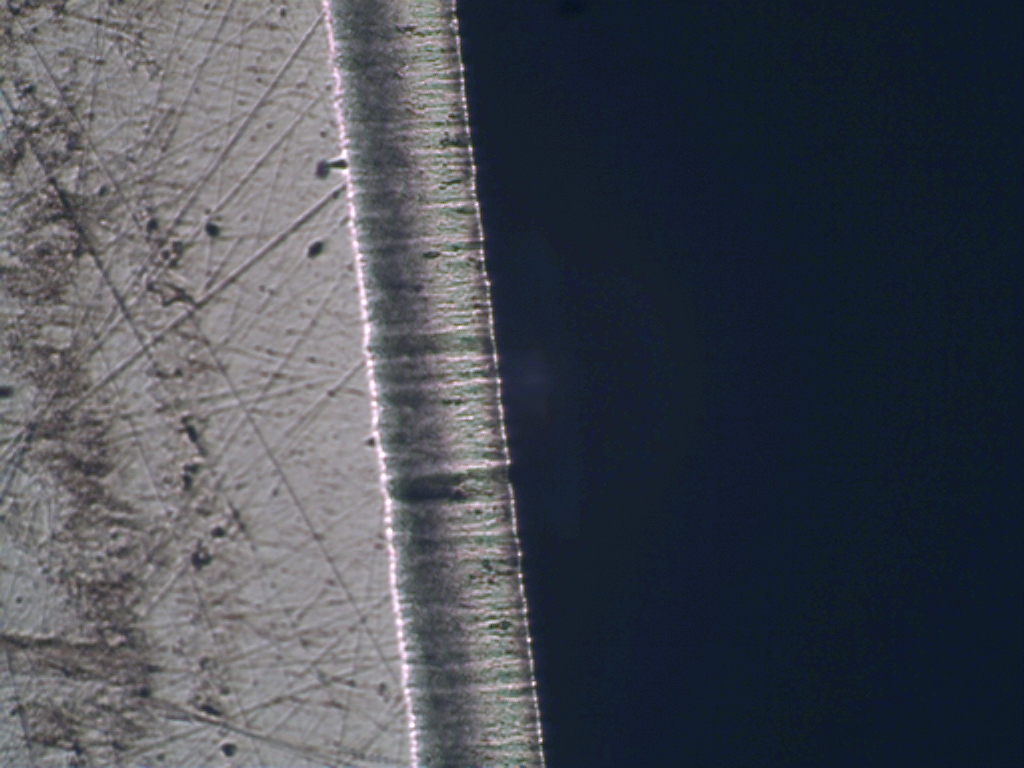
v11 at what must've been about 1670 feet
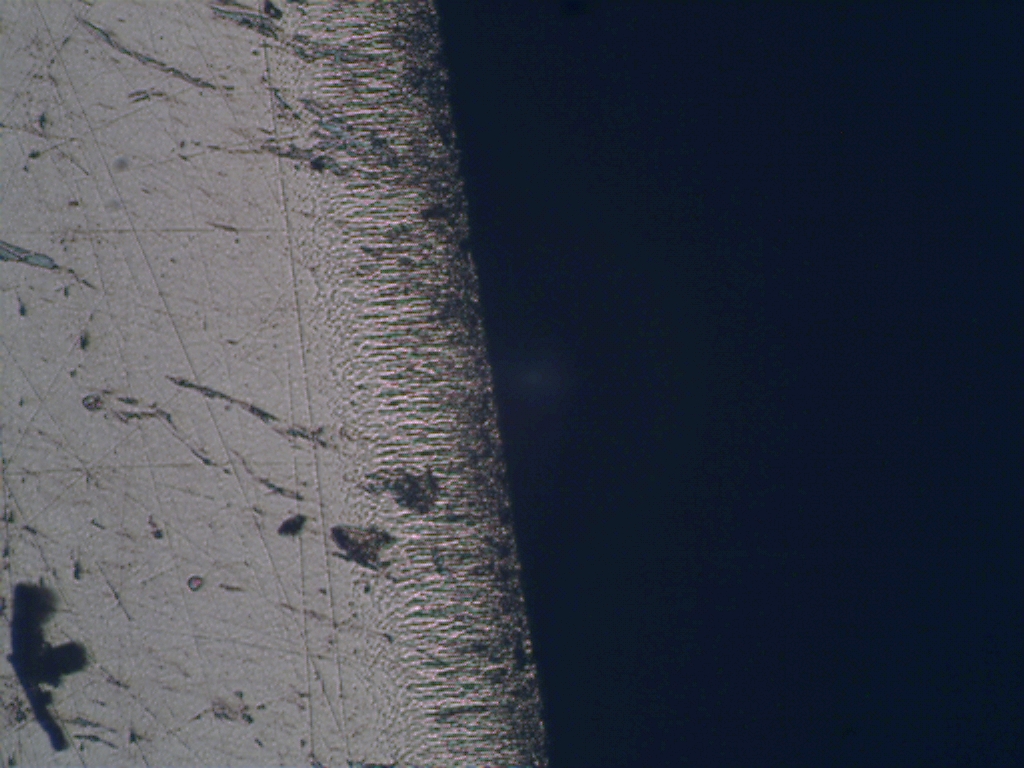
chinese hss at 1350 or so:
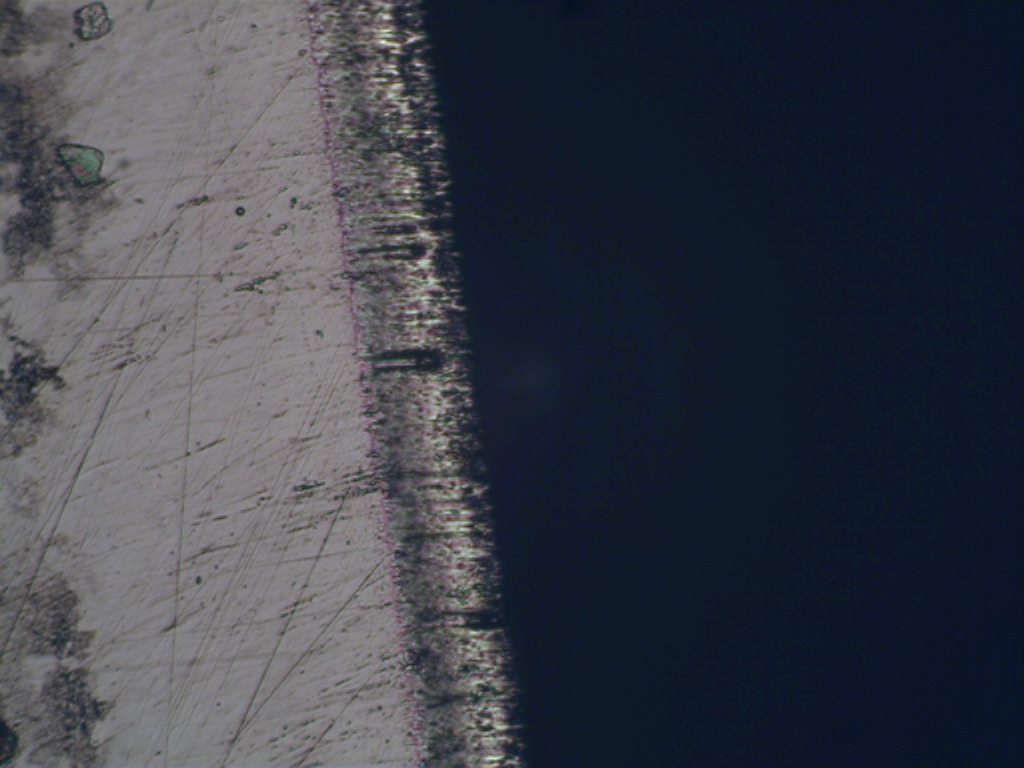
A2 at 980
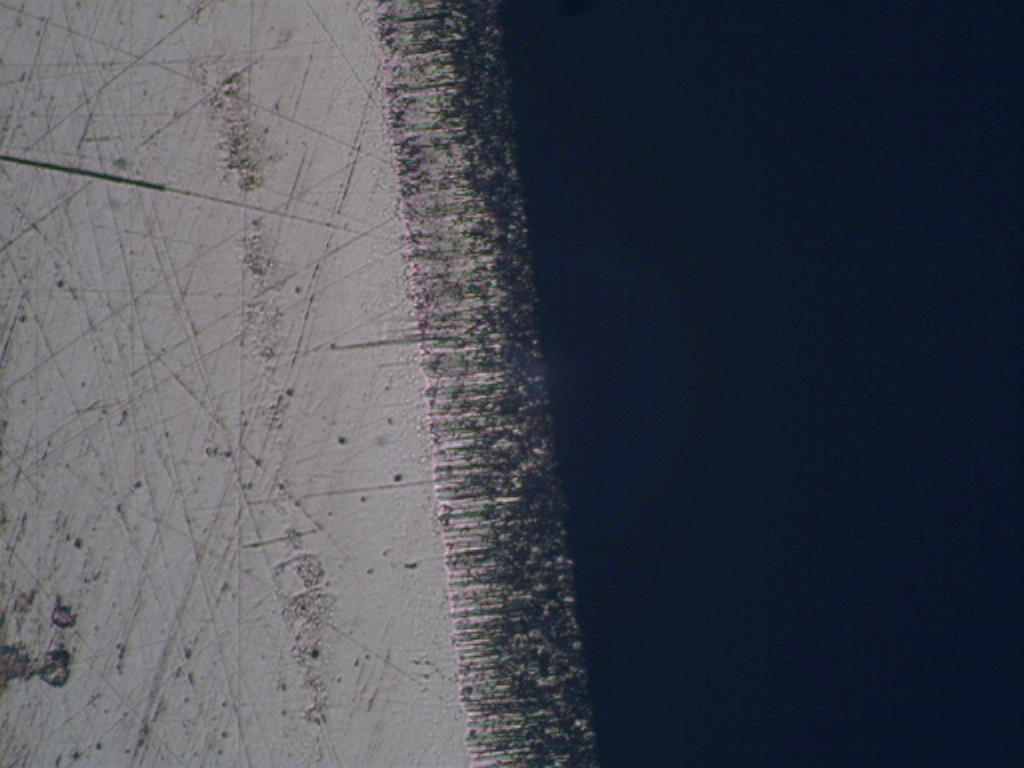
japanese blue steel at the same distance as 01 more or less (not sure what happened, but it had more friction and it looked like chunks coming out). I expected it to outlast most but it didn't. White steel would've lasted at or a little less than O1. (this is a hard thing for japanese enthusiasts to tolerate - but the alloying elements do really improve wear. Only in the PM do they not come at the cost of a more ragged edge)
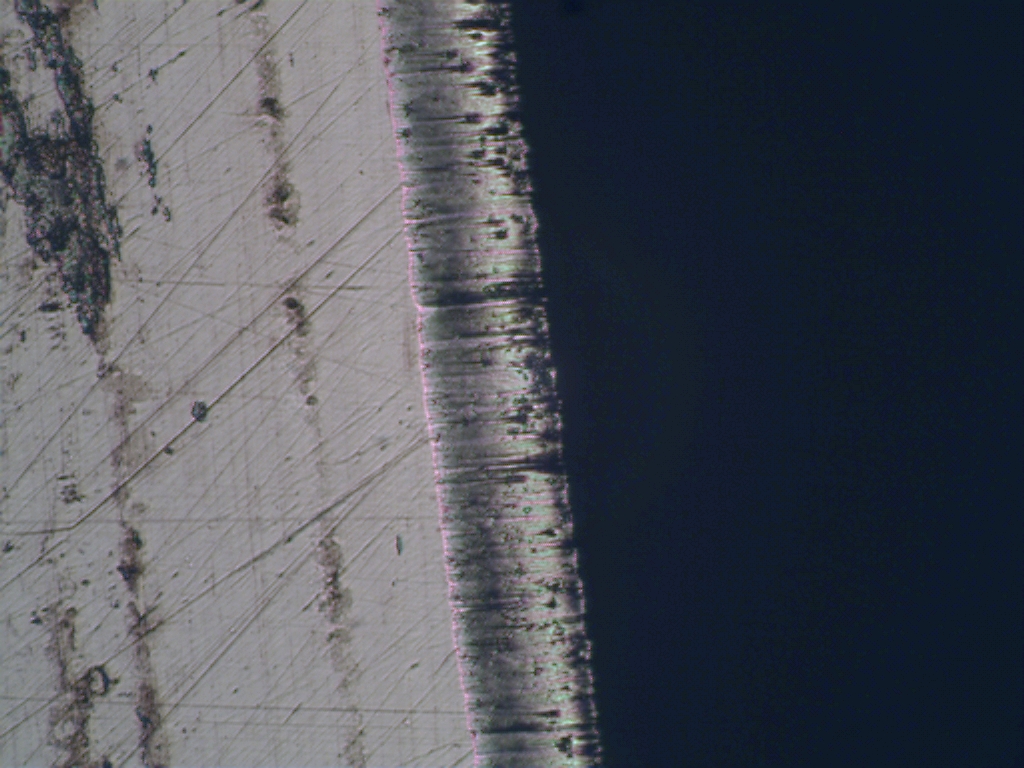
* O1 - 800 feet
* tsunesaburo blue steel - 800 feet
* A2 - 1000 feet
* chinese HSS - 1350 feet
* 3V - 1350 feet
* V11 - 1700 feet
That's how many feet of beech heart edge grain I planed with the same plane (weighed the shavings and alternated irons every 200 feet to ensure it was a fair fight) - 2 1/2 thousandth thickness. When a plane would struggle to stay in the cut without downforce above and beyond just pushing the plane on the back handle, the test was over.
subsequent test with M4, 3V and V11 showed a similar result with V11 vs. 3V and M4 (powder) was a couple of percent further (but much more work to push the entire time, and the edge looked worse).
I took pictures of the edges every two hundred feet.
O1 and V11 had the nicest looking edges, 3V was close. A2 comes apart in a strange way all at once and the edge looks like it's shedding itself under the scope.
Here is a dull O1 edge. Still looks pretty good (look how uniform the edge is) - 780 feet according to the image title (195 strokes)

v11 at what must've been about 1670 feet

chinese hss at 1350 or so:

A2 at 980

japanese blue steel at the same distance as 01 more or less (not sure what happened, but it had more friction and it looked like chunks coming out). I expected it to outlast most but it didn't. White steel would've lasted at or a little less than O1. (this is a hard thing for japanese enthusiasts to tolerate - but the alloying elements do really improve wear. Only in the PM do they not come at the cost of a more ragged edge)

Chinese HSS is a real champ, if you can manage to flatten it. Cost of the iron was $11 shipped from china, it fits in a stanley 4 (not overly thick) and it holds up well in clean wood and is a real champ on silica. (it's almost M2, but not quite - they got cheap on a couple of the alloying elements).
The brother iron of this (I gave one away) tested at 65 rc, so no wonder it seemed hard.
Bottom line, if you're smooth planing or jointing clean wood, the V11 claims are accurate.
Still think learning to sharpen as fast as possible is the most valuable thing, and though it will cause some who are early on in the hobby to have a negative reaction, that means no guide.
If one needs a guide at the outset, that's fine, but it's something to get away from unless hand tool use is very intermittent.
The brother iron of this (I gave one away) tested at 65 rc, so no wonder it seemed hard.
Bottom line, if you're smooth planing or jointing clean wood, the V11 claims are accurate.
Still think learning to sharpen as fast as possible is the most valuable thing, and though it will cause some who are early on in the hobby to have a negative reaction, that means no guide.
If one needs a guide at the outset, that's fine, but it's something to get away from unless hand tool use is very intermittent.
..this piece of wire is 7 thousandths thick, just to give some scale to these pictures.
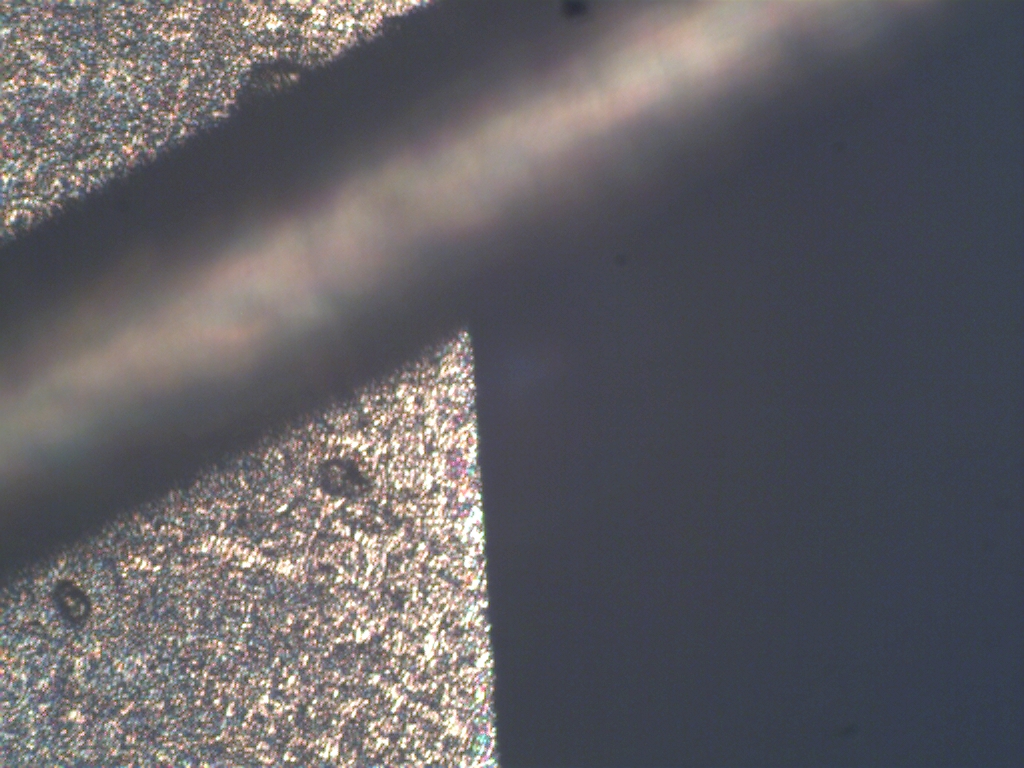
That picture looks unusual because it is a powder steel iron sharpened on a natural stone. it sort of tumbles some particles off rather than going through all of them.
(it's CPM 3V with a nice fast white japanese suita stone - a lovely wonderful natural stone that rewards a non-jig sharpener, and I can find them from time to time on japanese proxy sites for about $60 plus $30 shipping from japan - each is a lifetime of sharpening).

That picture looks unusual because it is a powder steel iron sharpened on a natural stone. it sort of tumbles some particles off rather than going through all of them.
(it's CPM 3V with a nice fast white japanese suita stone - a lovely wonderful natural stone that rewards a non-jig sharpener, and I can find them from time to time on japanese proxy sites for about $60 plus $30 shipping from japan - each is a lifetime of sharpening).
dannyr
Established Member
Thanks - looks like you've done a lot of work, and thorough.
I was once in the business, but for home workshop hand tools I have only ever used old Sheffield steel stamped by makers such as Wards and Marples. (having said that, I bought a couple of v cheap Chinese socket chisels in the late 70s, used them as scrapers etc then found they are quite good hss laminated to steel.)
I was once in the business, but for home workshop hand tools I have only ever used old Sheffield steel stamped by makers such as Wards and Marples. (having said that, I bought a couple of v cheap Chinese socket chisels in the late 70s, used them as scrapers etc then found they are quite good hss laminated to steel.)
Jacob
New Luddism. Awake and resist!
The OP was asking for Easiest Blade and Chisel Sharpening advice. :lol: :lol:
Highly predictable but this thread has gone off in every other possible direction!
To get back to reality:
"There are 100s of ways .....etc"
Basically there's just one - rubbing your bit of steel on a bit of stone.
"There are lots of bevel angles, primary, secondary etc .....etc"
Basically there's just one - 30º and it's easy to get right freehand. You need to get into the habit of visualising this but it is easy - draw a right angle and divide into 3, draw an equilateral triangle and bisect the corner angle
You have to flatten things
Only if you use a jig or soft waterstones. Don't!
There are so many varieties of steel....
If you are a woodworker it's just steel. All you need to know. When you are good enough at it to know; if a piece is very difficult to sharpen, or too soft to hold an edge, just bin it, or put it aside.
Freehand is difficult....
Can't argue with those who say they can't do it but basically it's very easy and almost anybody can. It's easy to talk yourself out of it (as they have done). On a skill level it's easier than say learning to ride a bike but slightly more difficult than sharpening a pencil. It's the method used by virtually every sharpener at every level of skill since the stone age.
Rounded bevels are bad....
Only if rounded over so that the edge angle is too high, but rounding back the back of the bevel under 30º is perfectly OK and makes freehand sharpening much easier.
The one critical thing which most mystifies beginners is "the burr". You need to be able to recognise that you have brought up the burr across the whole width of the blade and then turn it over and take it off. This is the process in a nutshell.
A quick strop helps polish the bevel and reduce friction but is not essential and you don't really need compounds. TBH I sometimes use a squidge of Autosol.
Highly predictable but this thread has gone off in every other possible direction!
To get back to reality:
"There are 100s of ways .....etc"
Basically there's just one - rubbing your bit of steel on a bit of stone.
"There are lots of bevel angles, primary, secondary etc .....etc"
Basically there's just one - 30º and it's easy to get right freehand. You need to get into the habit of visualising this but it is easy - draw a right angle and divide into 3, draw an equilateral triangle and bisect the corner angle
You have to flatten things
Only if you use a jig or soft waterstones. Don't!
There are so many varieties of steel....
If you are a woodworker it's just steel. All you need to know. When you are good enough at it to know; if a piece is very difficult to sharpen, or too soft to hold an edge, just bin it, or put it aside.
Freehand is difficult....
Can't argue with those who say they can't do it but basically it's very easy and almost anybody can. It's easy to talk yourself out of it (as they have done). On a skill level it's easier than say learning to ride a bike but slightly more difficult than sharpening a pencil. It's the method used by virtually every sharpener at every level of skill since the stone age.
Rounded bevels are bad....
Only if rounded over so that the edge angle is too high, but rounding back the back of the bevel under 30º is perfectly OK and makes freehand sharpening much easier.
The one critical thing which most mystifies beginners is "the burr". You need to be able to recognise that you have brought up the burr across the whole width of the blade and then turn it over and take it off. This is the process in a nutshell.
A quick strop helps polish the bevel and reduce friction but is not essential and you don't really need compounds. TBH I sometimes use a squidge of Autosol.
Similar threads
- Replies
- 61
- Views
- 4K




